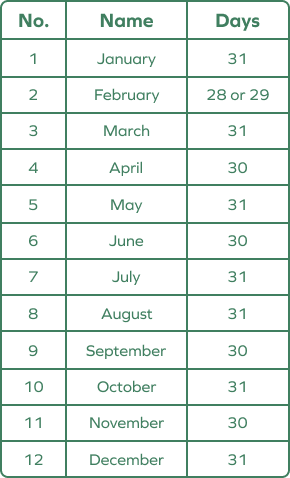What Is a Year?
A year is the time taken by Earth to make one revolution around the Sun. A year can also be described as a period of 12 months (365 days or 366 days), starting from the first of January and ending on the thirty-first of December.

One complete calendar year can also be expressed as
- This year’s 4th of July to the next year’s 4th of July
- This year’s Christmas day to the next year’s Christmas day
- Your last birthday to your next birthday
 Begin here
Begin here
Year Definition
A year is the time taken by the earth to make one revolution around the sun. It is the period of 12 months measured from any particular date.
Related Worksheets
Ordinary Year and Leap Year
How many days are there in a year? We will discuss this for two cases. There are two types of years:
- Ordinary Year
An ordinary year has 365 days.
- Leap Year
Leap year has 366 days. Earth orbits the Sun in 365.25 days on average. The days in a calendar year are typically rounded up to 365. We add a day to our calendar every four years or so to make up for the lost part of the day. That is a leap year, when an extra day is added to the end of the shortest month, i.e., February. Intercalary Day is the name given to this day, usually referred to as Leap Day, February 29.
How Many Months Are There in a Year?
There are 12 months in a year. The names of the months are:

Number of Days in a Year
The first day of the year is 1st January and the last day is 31 December.
In an ordinary year, there are seven months each having 31 days, 4 months each having 30 days and 1 month having 28 days.
Number of days in an ordinary year $= (7 \times 31) + (4 \times 30) + (1 \times 28)$
$= 217 + 120 + 28$
$= 365$ days
Number of days in a leap year $= (7 \times 31) + (4 \times 30) + (1 \times 29)$
$= 217 + 120 + 29$
$= 366$ days
Average Weeks in a Year
The duration of the Earth’s complete rotation with regard to the Sun is defined as one day. The Earth rotates about its axis once every 24 hours.

There are 7 days in a week which are as follows:
Monday, Tuesday, Wednesday, Thursday, Friday, Saturday, and Sunday.
There are 365 or 366 days in a year depending on whether it is an ordinary or leap year. So, how many weeks are there in a year? Let’s find out.
Number of weeks in an ordinary year $= \frac{365}{7} = 52$ weeks $+ 1$ day
Number of weeks in a leap year $= \frac{366}{7} = 52$ weeks $+ 2$ days
Fun Facts
- In astronomy, a Julian year is a measurement unit of time, which is defined as exactly 365.25 days of 86400 SI seconds each.
- The lunar year consists of twelve full cycles of the phases of the Moon (roughly 354 days).
- The galactic year, which is also known as a cosmic year, is termed as the duration of time required for the Sun to orbit once around the center of the Milky Way Galaxy.
- A fiscal or financial year is a 12-month period for calculating annual financial statements in businesses and other organizations
- The annual period during which a student attends an educational institution is known as an academic year. It may be divided into semesters or quarters.
- If today is Monday, it will be again a Monday after 7 days as the 7-day cycle repeats itself.
How to Check Which Year is a Leap Year
Step 1: Check if the year is divisible by 4.
If it is not, it is not a leap year.
Example: 2017 is not a leap year.
Step 2: If the year is divisible by 4, and also divisible by 100, it is not a leap year.
Example: 2300 is not a leap year.
Step 3: If the year is divisible by 4, and also divisible by 400, it is a leap year.
Example: 1600, 2000 are leap years.
10 years, 100 years, 1000 years
- 10 years make one decade.
- 100 years make one century. Meaning of 100 years can also be described using the word “centennial.” A centenary is the hundredth anniversary of some event.
- 1000 years make one millennium.
The years from 1800 to 1899 are called the nineteenth century.
The years from 2000 to 2099 are called the twenty-first century.
Conclusion
In this article, we learned about a year. A year is a specified period of time having 365 or 366 days. Let’s check out some examples and practice problems.
Solved Examples on Year
1. Arrange the months of the year in the correct order. How many months make a year?
Solution:
There are 12 months in a year.
The correct order of the months is:
January, February, March, April, May, June, July, August, September, October, November, and December.
2. How many days are there in the first 6 months of an ordinary year?
Solution:
The first 6 months are: January, February, March, April, May, June.
Number of days in January $= 31$
Number of days in February $= 28$
Number of days in March $= 31$
Number of days in April $= 30$
Number of days in May $= 31$
Number of days in June $= 30$
Number of days in first 6 months $= (3 \times 31) + (2 \times 30) + (1 \times 28) = 93 + 60 + 28$
$= 181$ days
3. Check whether 2070 is a leap year or not.
Solution:
$2070 \div 4 = 517.5$ which means 2070 is not completely divisible by 4.
So, it is not a leap year.
4. How many months with 31 days are there in a year?
Solution:
Months having 31 days $=$ January, March, May, July, August, October, December.
Number of months having 31 days $= 6$
5. If today is Saturday, what will be the day after 50 days?
Solution:
Each day of the week is repeated after 7 days.
So, after 49 days, it will be Saturday.
$\therefore$ After 50 days, it will be Sunday.
Practice Problems
Year in Math
Which of the following is an odd one out?
All months except December have 30 days.
How many days are there in a leap year?
A leap year has 366 days.
How many weeks are there in an ordinary year?
Number of days in an ordinary year $= 365$ Number of days in a week $= 7$ Number of weeks $= \frac{365}{7} = 52$ weeks $+ 1$ day
Which of the following is a leap year?
Only 800 is exactly divisible by 400. So, 800 is a leap year.
500, 100, 1000 are divisible by 100. Thus, these are not leap years.
If tomorrow is Wednesday, what was the day before yesterday?
Tomorrow is Wednesday.
Today is Tuesday.
Yesterday was Monday.
Day before yesterday was Sunday.
Frequently Asked Questions on Year
What is the period of 5 years called?
The period of 5 years is known as Lustrum.
What is the use of year?
We use year to refer to the age of a person. For example, if someone or something is fifteen years old, they have lived or existed for fifteen years.
What is the other word used for “year”?
The other word used for “year” is annum.
Which word has been used for ten thousand years?
We use decamillennium for a period of ten thousand years.
How many days are there in a school year in the USA?
The National Center for Education Statistics (NCES) estimates that a school year has about $175 − 180$ days but that also depends on states, districts, and other factors.
How many days are there in 4 years?
There are $(365 \times 4) + 1 = 1461$ days in 4 years. One extra day is added due to the presence of a leap year.
How many days are there in 2 years (ordinary)?
There are 730 days in two ordinary years.
How many weekend days are there in a year?
The weekend includes Saturday and Sunday. There are 52 weeks in a year. So, there are 52 weekends. Thus, there are $52 \times 2 = 104$ weekend days in a year.





















